Dynamic Response Characteristics of Railway Subgrade Using a Newly-Developed Prestressed Reinforcement Structure: Case Study of a Model Test
Abstract
:1. Introduction
2. Experimental Overview of Physical Model Test
2.1. Similitude Principle
2.2. Model Geometry and Testing System Composition
2.3. Track-Subgrade-Foundation Construction
2.4. Loading Platform and Test Program
2.5. Sensor Arrangement
3. Prestress Loss of Steel Bars
4. Results and Discussions of Short-Term Loading Tests
4.1. Acceleration Response at Measurement Points
4.2. Influence of Axle Load
4.3. Influence of Reinforcement Pressure
5. Results and Discussions of Long-Term Loading Tests
6. Conclusions
- (1)
- After the pretension of the steel bar, there was a prestress loss due to the soil creep behavior and anchor group effect. Specifically, after 74 h of pretension, the prestress loss of the steel bars in each row was around 10% on average. Consequently, it is suggested to provide moderate over-tension for steel bars in practice.
- (2)
- An apparent periodic response of the prestressed subgrade subjected to cyclic loads was observed, and the vibration energy gradually attenuated downward of the slope. At the same measurement height, the horizontal peak acceleration was up to 75% of the vertical peak magnitude, implying that the horizontal vibration acceleration of the subgrade induced by the moving train load cannot be neglected.
- (3)
- The peak accelerations in both the horizontal and vertical directions showed an approximately linear increase with an increasing train axle load at all of the measurement points, and the influence degree in the vertical direction was relatively more sensitive. The peak acceleration response weakened with an increase in the reinforcement pressure, which means that the increasing reinforcement pressure could contribute to the mitigation of the subgrade vibration, and thus, the smoothness and safety of train operations can be improved. However, the reinforcement pressure had an upper limit considering both the shear strength and compressibility of the subgrade soil, and thus, it is necessary to further investigate the optimal reinforcement pressure for various subgrade conditions.
- (4)
- In the long-term tests, without reinforcement pressure, the effective value of the vertical acceleration of the subgrade was almost unchanged with the increasing cyclic loads; in contrast, once the reinforcement pressure reached 100 kPa, it showed a decreasing tendency first and then tended to be stable as the loading cycles increased, and the latter value was around 81% of the former.
Author Contributions
Funding
Institutional Review Board Statement
Informed Consent Statement
Data Availability Statement
Acknowledgments
Conflicts of Interest
References
- Dash, S.K.; Majee, A. Geogrid reinforcement for stiffness improvement of railway track formation over clay subgrade. Int. J. Geomech. 2021, 21, 04021163. [Google Scholar] [CrossRef]
- Zhang, Q.S.; Leng, W.M.; Zhai, B.; Xu, F.; Dong, J.L.; Yang, Q. Evaluation of critical dynamic stress and accumulative plastic strain of an unbound granular material based on cyclic triaxial tests. Materials 2021, 14, 5722. [Google Scholar] [CrossRef] [PubMed]
- Leng, W.M.; Nie, R.S.; Yang, Q.; Zhao, C.Y.; Mei, H.H. A new type of prestressed embankment structure and its properties. J. China Railw. Soc. 2016, 38, 111–119. [Google Scholar]
- Lazorenko, G.; Kasprzhitskii, A.; Khakiev, Z.; Yavna, V. Dynamic behavior and stability of soil foundation in heavy haul railway tracks: A review. Constr. Build. Mater. 2019, 205, 111–136. [Google Scholar] [CrossRef]
- Zhang, Q.S.; Leng, W.M.; Xu, F.; Yang, Q.; Ai, X. Additional stress in soil embankment subjected to a new prestressed reinforcement device. J. Civ. Eng. Manag. 2019, 25, 700–714. [Google Scholar] [CrossRef]
- Leng, W.M.; Ai, X.; Xu, F.; Zhang, Q.S.; Yang, Q.; Nie, R.S.; Liu, X.H. Diffusion laws of horizontal additional stress in a new prestressed subgrade. Chin. J. Geotech. Eng. 2019, 41, 1445–1454. [Google Scholar]
- Zhang, Q.S.; Leng, W.M.; Xu, F.; Ruan, B.; Ye, X.Y.; Zhou, Y. Stability analysis method for a prestressed railway embankment considering the additional stresses propagation effect. Lithosphere 2022, 2022, 6928614. [Google Scholar] [CrossRef]
- Leng, W.M.; Zhang, Q.S.; Xu, F.; Leng, H.K.; Yang, Q.; Nie, R.S. Numerical research on the prestressed reinforcement technology of railway embankment. J. Railw. Eng. Soc. 2020, 1, 6–11+114. [Google Scholar]
- Leng, W.M.; Dong, J.L.; Xu, F.; Zhao, C.Y.; Ruan, B.; Ye, X.Y.; Zhang, Q.S. Determination method of lateral pressure plate spacing of a prestressed embankment. J. Railw. Sci. Eng. 2022, 19, 100–111. [Google Scholar]
- Bian, X.C.; Jiang, H.G.; Chen, Y.M. Accumulative deformation in railway track induced by high-speed traffic loading of the trains. Earthq. Eng. Eng. Vib. 2010, 9, 319–326. [Google Scholar] [CrossRef]
- Kennedy, J.H.; Woodward, P.K.; Banimahd, M.; Medero, G.M. Railway track performance study using a new testing facility. Proc. Inst. Civ. Eng.-Geotech. Eng. 2012, 165, 309–319. [Google Scholar] [CrossRef]
- Brown, S.F.; Brodrick, B.V.; Thom, N.H.; McDowell, G.R. The Nottingham railway test facility, UK. Proc. Inst. Civ. Eng.-Transp. 2007, 160, 59–65. [Google Scholar] [CrossRef]
- Shaer, A.A.; Duhamel, D.; Sab, K.; Foret, G.; Schmitt, L. Experimental settlement and dynamic behavior of a portion of ballasted railway track under high speed trains. J. Sound Vib. 2008, 316, 211–233. [Google Scholar] [CrossRef]
- Ishikawa, T.; Sekine, E.; Miura, S. Cyclic deformation of granular material subjected to moving-wheel loads. Can. Geotech. J. 2011, 48, 691–703. [Google Scholar] [CrossRef] [Green Version]
- Chen, J.; Zhou, Y.; Zhou, G.X.; Fu, B. Experimental vibration investigation on high-speed railway ballastless track-subgrade structure. Int. J. Struct. Stab. Dyn. 2020, 20, 2050081. [Google Scholar] [CrossRef]
- Zhang, J.W.; Cai, C.B.; Zhu, S.Y.; Wang, M.Z.; He, Q.L.; Yang, S.F.; Zhai, W.M. Experimental investigation on dynamic performance evolution of double-block ballastless track under high-cycle train loads. Eng. Struct. 2022, 254, 113872. [Google Scholar] [CrossRef]
- Momoya, Y.; Takahashi, T.; Nakamura, T. A study on the deformation characteristics of ballasted track at structural transition zone by multi-actuator moving loading test apparatus. Transp. Geotech. 2016, 6, 123–134. [Google Scholar] [CrossRef]
- Fortunato, E.; Paixão, A.; Morais, P.; Santos, C.; Morais, J.; Cruz, J.; Cruz, N. Subgrade reinforcement of old railway tracks using short soil–binder columns–Laboratory studies and field tests. Transp. Geotech. 2021, 29, 100577. [Google Scholar] [CrossRef]
- Brough, M.J.; Ghataora, G.; Stirling, A.B.; Madelin, K.B.; Rogers, C.D.; Chapman, D.N. Investigation of railway track subgrade, Part 2: Case study. In Proceedings of the Institution of Civil Engineers-Transport; Thomas Telford Ltd.: London, UK, 2006; Volume 159, pp. 83–92. [Google Scholar]
- Zhang, X.; Zhao, C.F.; Zhai, W.M.; Shi, C.; Feng, Y. Investigation of track settlement and ballast degradation in the high-speed railway using a full-scale laboratory test. Proc. Inst. Mech. Eng. Part F J. Rail Rapid Transit 2019, 233, 869–881. [Google Scholar] [CrossRef]
- Zhai, W.M.; Wang, K.Y.; Chen, Z.W.; Zhu, S.Y.; Cai, C.B.; Liu, G. Full-scale multi-functional test platform for investigating mechanical performance of track–subgrade systems of high-speed railways. Railw. Eng. Sci. 2020, 28, 213–231. [Google Scholar] [CrossRef]
- Hu, P.; Zhang, C.S.; Chen, S.J.; Wang, Y.H.; Wang, W.; Duan, W.H. Dynamic responses of bridge–embankment transitions in high speed railway: Field tests and data analyses. Eng. Struct. 2018, 175, 565–576. [Google Scholar] [CrossRef]
- Li, P.; Ling, X.Z.; Zhang, F.; Li, Y.; Zhao, Y.Y. Field Testing and Analysis of Embankment Vibrations Induced by Heavy Haul Trains. Shock. Vib. 2017, 2017, 7410836. [Google Scholar] [CrossRef]
- Mei, H.H.; Leng, W.M.; Nie, R.S.; Tu, R.P.; Li, Y.F.; Dong, J.L. Experimental research on the dynamic response characteristics of the transition subgrade induced by heavy-haul train passage. Proc. Inst. Mech. Eng. Part F J. Rail Rapid Transit 2019, 233, 974–987. [Google Scholar] [CrossRef]
- Wang, L.L. Vibration characterization of fully-closed high speed railway subgrade through frequency: Sweeping test. Soil Dyn. Earthq. Eng. 2016, 88, 33–44. [Google Scholar] [CrossRef]
- Xiao, J.H.; Wang, B.L.; Liu, C.Y.; Yu, Z. Influences of Subgrade Form and Ground Stiffness on Dynamic Responses of Railway Subgrade under Train Loading: Field Testing Case Study. Procedia Eng. 2016, 143, 1185–1192. [Google Scholar] [CrossRef]
- Zhai, W.M.; Wei, K.; Song, X.L.; Shao, M.H. Experimental investigation into ground vibrations induced by very high speed trains on a non-ballasted track. Soil Dyn. Earthq. Eng. 2015, 72, 24–36. [Google Scholar] [CrossRef]
- Kouroussis, G.; Verlinden, O.; Conti, C. Free field vibrations caused by high-speed lines: Measurement and time domain simulation. Soil Dyn. Earthq. Eng. 2011, 31, 692–707. [Google Scholar] [CrossRef]
- Cai, Y.; Xu, L.R.; Liu, W.Z.; Shang, Y.H.; Su, N.; Feng, D. Field Test Study on the dynamic response of the cement-improved expansive soil subgrade of a heavy-haul railway. Soil Dyn. Earthq. Eng. 2020, 128, 105878. [Google Scholar] [CrossRef]
- Dong, J.; Yang, Y.; Wu, Z.H. Propagation characteristics of vibrations induced by heavy-haul trains in a loess area of the North China Plains. J. Vib. Control 2019, 25, 882–894. [Google Scholar] [CrossRef]
- Tian, S.; Tang, L.; Ling, X.Z.; Ye, Y.S.; Li, S.Z.; Zhang, Y.J.; Wang, W. Field investigation into the vibration characteristics at the embankment of ballastless tracks induced by high-speed trains in frozen regions. Soil Dyn. Earthq. Eng. 2020, 139, 106387. [Google Scholar] [CrossRef]
- Gao, Y.; Huang, H.; Ho, C.L.; Judge, A. Field validation of a three-dimensional dynamic track-subgrade interaction model. Proc. Inst. Mech. Eng. Part F J. Rail Rapid Transit 2018, 232, 130–143. [Google Scholar] [CrossRef]
- Zhang, J.Y.; He, Z.L.; Chen, S.Y.; Zhang, L. Vibration Response Characteristics and Application of Existing Railway Subgrade. Shock. Vib. 2021, 2021, 9926980. [Google Scholar] [CrossRef]
- Wang, Z.Y.; Ling, X.Z.; Wang, L.N.; Zhao, Y.Y. Attenuation Law of Train-Induced Vibration Response of Subgrade in Beijing-Harbin Railway. Shock. Vib. 2021, 2021, 9000970. [Google Scholar] [CrossRef]
- Cao, L.C.; Yang, C.W.; Zhang, J.J.; Zeng, P.Y.; Li, S.F. Earthquake response of the train–slab ballastless track–subgrade system: A shaking table test study. J. Vib. Control 2020, 27, 17–18. [Google Scholar] [CrossRef]
- Cao, L.C.; Yang, C.W.; Zhang, J.J. Derailment Behaviors of the Train-Ballasted Track-Subgrade System Subjected to Earthquake Using Shaking Table. KSCE J. Civ. Eng. 2020, 24, 2949–2960. [Google Scholar] [CrossRef]
- Brand, L. The Pi theorem of dimensional analysis. Arch. Ration. Mech. Anal. 1957, 1, 35–45. [Google Scholar] [CrossRef]
- Curtis, W.D.; Logan, J.D.; Parker, W.A. Dimensional analysis and the Pi theorem. Linear Algebra Appl. 1982, 47, 117–126. [Google Scholar] [CrossRef]
- Lee, C.J.; Wei, Y.C.; Kuo, Y.C. Boundary effects of a laminar container in centrifuge shaking table tests. Soil Dyn. Earthq. Eng. 2012, 34, 37–51. [Google Scholar] [CrossRef]
- NRA (TB 10625-2017); Code for Design of Heavy Haul Railway. China Railway Publishing House: Beijing, China, 2017.
- NRA(TB 10001-2016); Code for Design of Railway Earth Structure. China Railway Publishing House: Beijing, China, 2016.
- Krylov, V.; Ferguson, C. Calculation of low-frequency ground vibrations from railway trains. Appl. Acoust. 1994, 42, 199–213. [Google Scholar] [CrossRef]
- Punetha, P.; Nimbalkar, S.; Khabbaz, H. Simplified geotechnical rheological model for simulating viscoelasto-plastic response of ballasted railway substructure. Int. J. Numer. Anal. Methods Geomech. 2021, 45, 2019–2047. [Google Scholar] [CrossRef]
- Punetha, P.; Nimbalkar, S.; Khabbaz, H. Analytical Evaluation of Ballasted Track Substructure Response under Repeated Train Loads. Int. J. Geomech. 2020, 20, 04020093. [Google Scholar] [CrossRef]
- Leng, W.M.; Mei, H.H.; Nie, R.S.; Zhao, C.Y.; Liu, W.J.; Su, Y. Full-scale model test of heavy haul railway subgrade. J. Vib. Shock. 2018, 37, 1–6+18. [Google Scholar]
- Nie, R.S.; Leng, W.M.; Zhang, J.S.; Yu, Z.W. Invention and application of train-induced dynamic loading system. J. China Railw. Soc. 2016, 38, 96–101. [Google Scholar]
- Bian, X.C.; Jiang, H.G.; Chen, Y.M.; Jiang, J.Q.; Han, J. A full-scale physical model test apparatus for investigating the dynamic performance of the slab track system of a high-speed railway. Proc. Inst. Mech. Eng. Part F J. Rail Rapid Transit 2014, 230, 554–571. [Google Scholar] [CrossRef]
- Di, H.G.; Leng, W.M.; Xue, J.L.; Zhou, S.H. Assessment of subgrade strength for transport capacity enlargement of Shuo-Huang heavy-haul railway. J. China Railw. Soc. 2014, 36, 84–90. [Google Scholar]
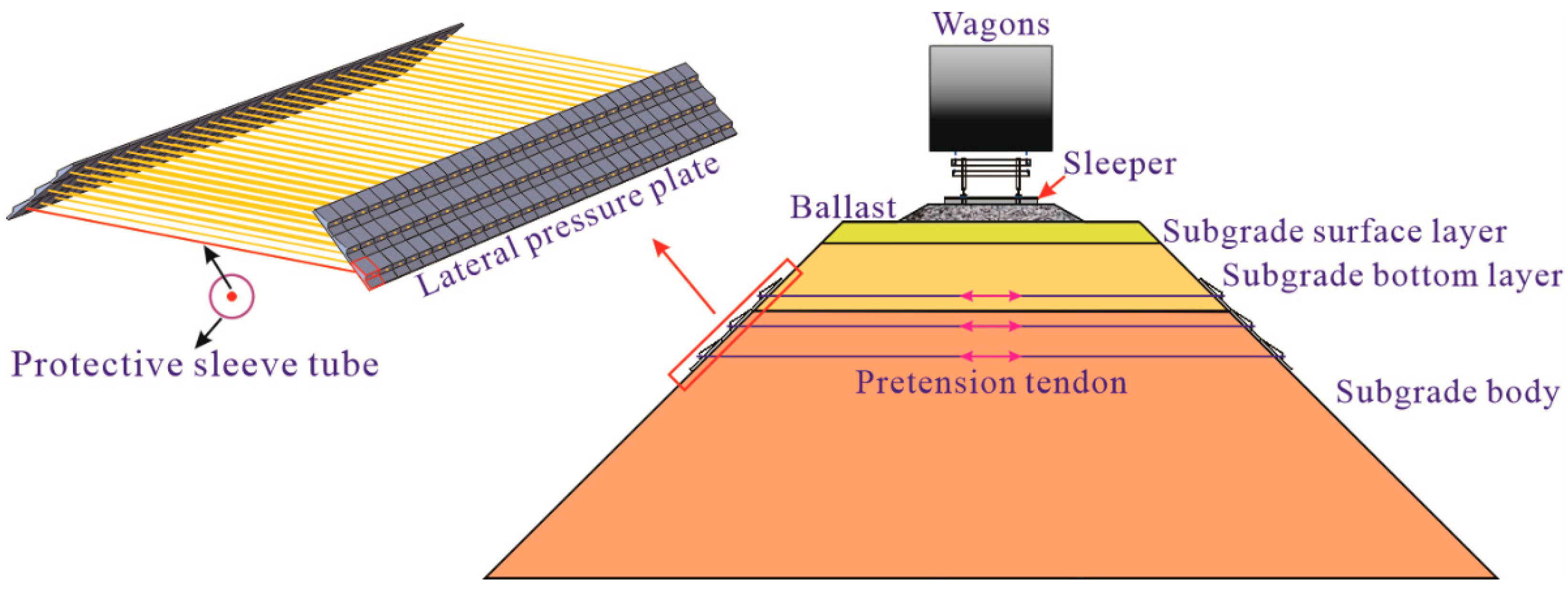

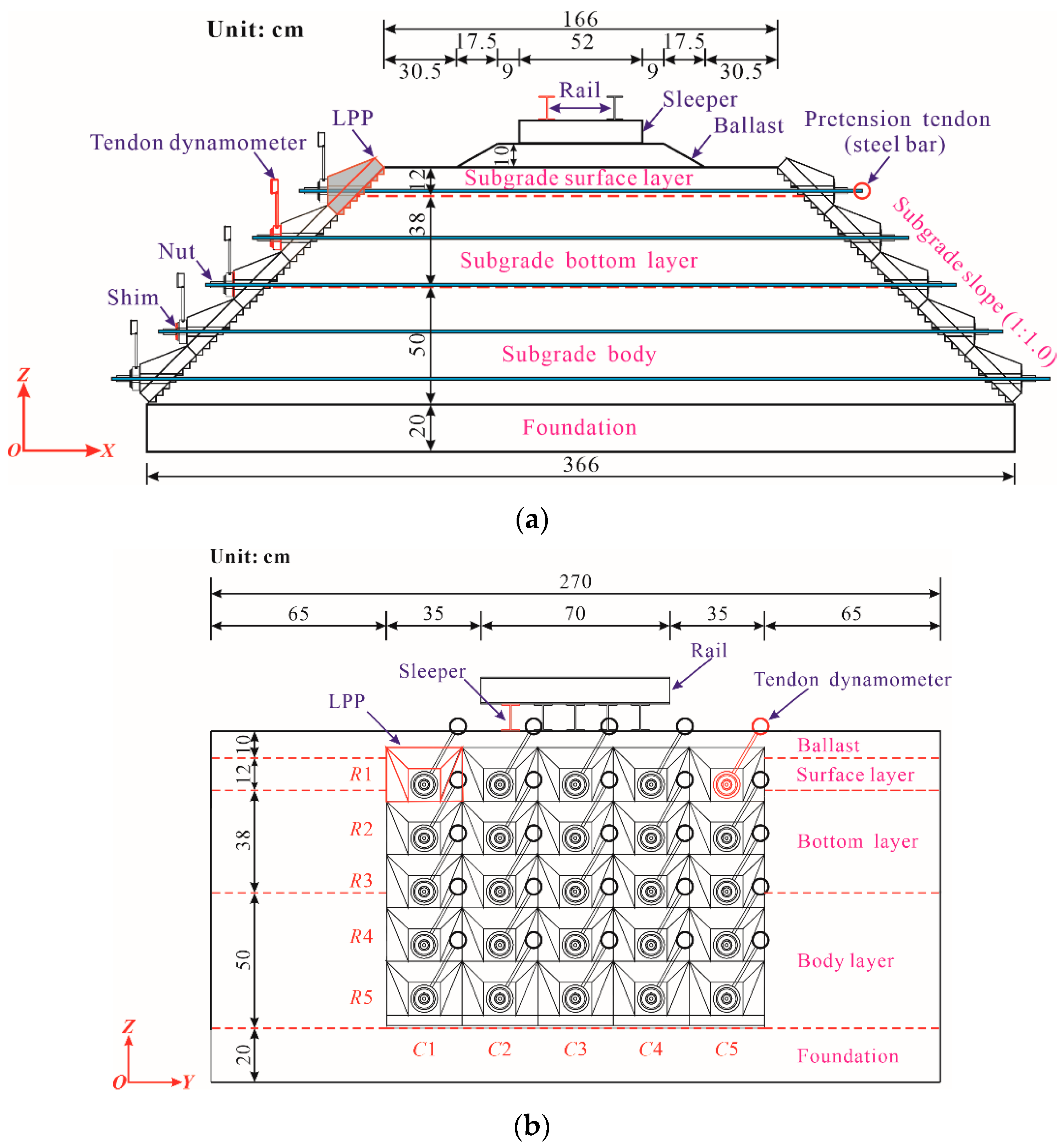


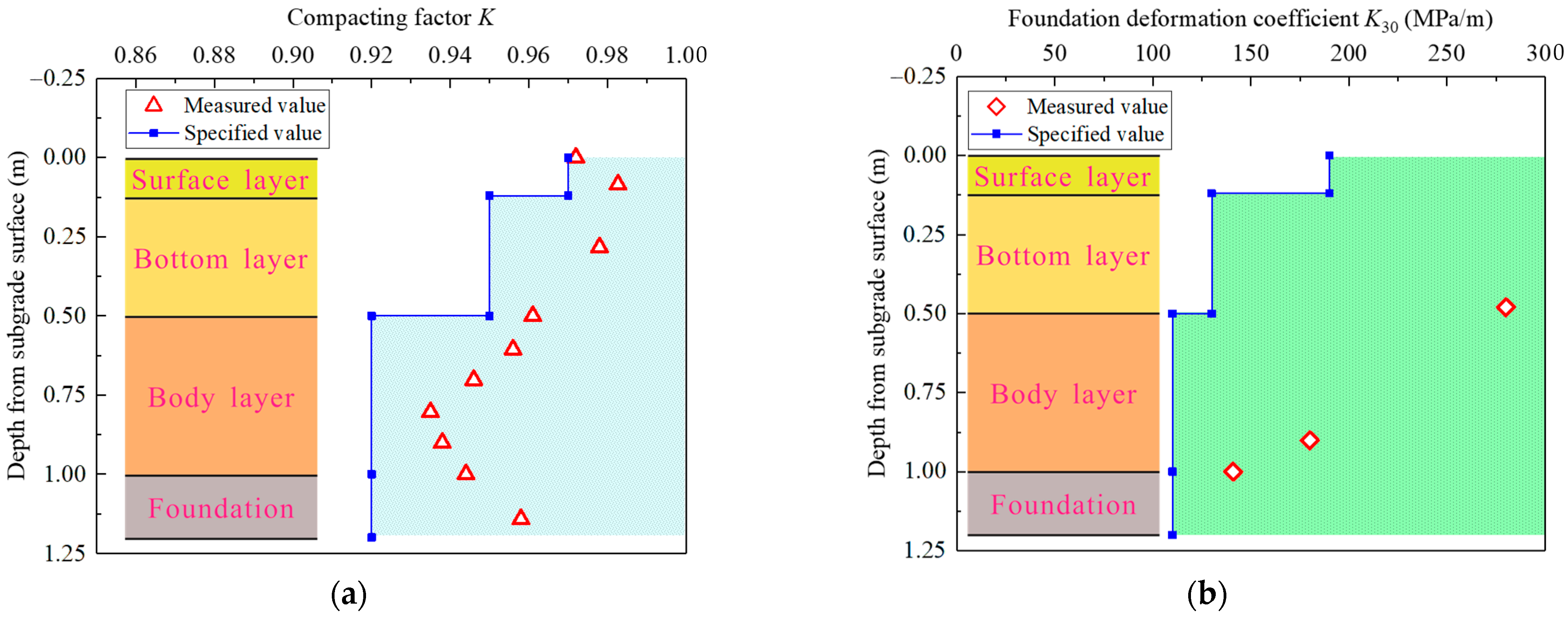
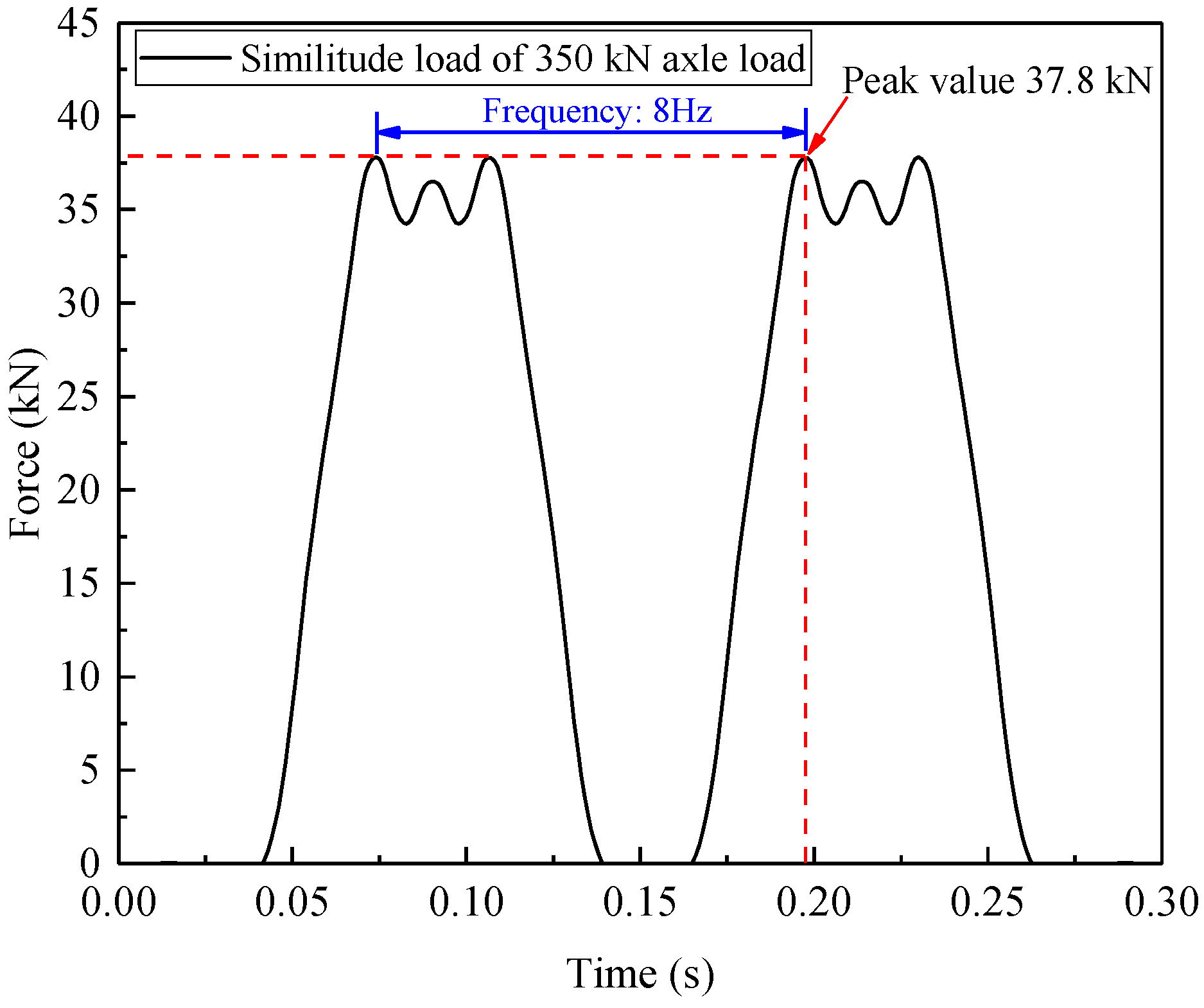
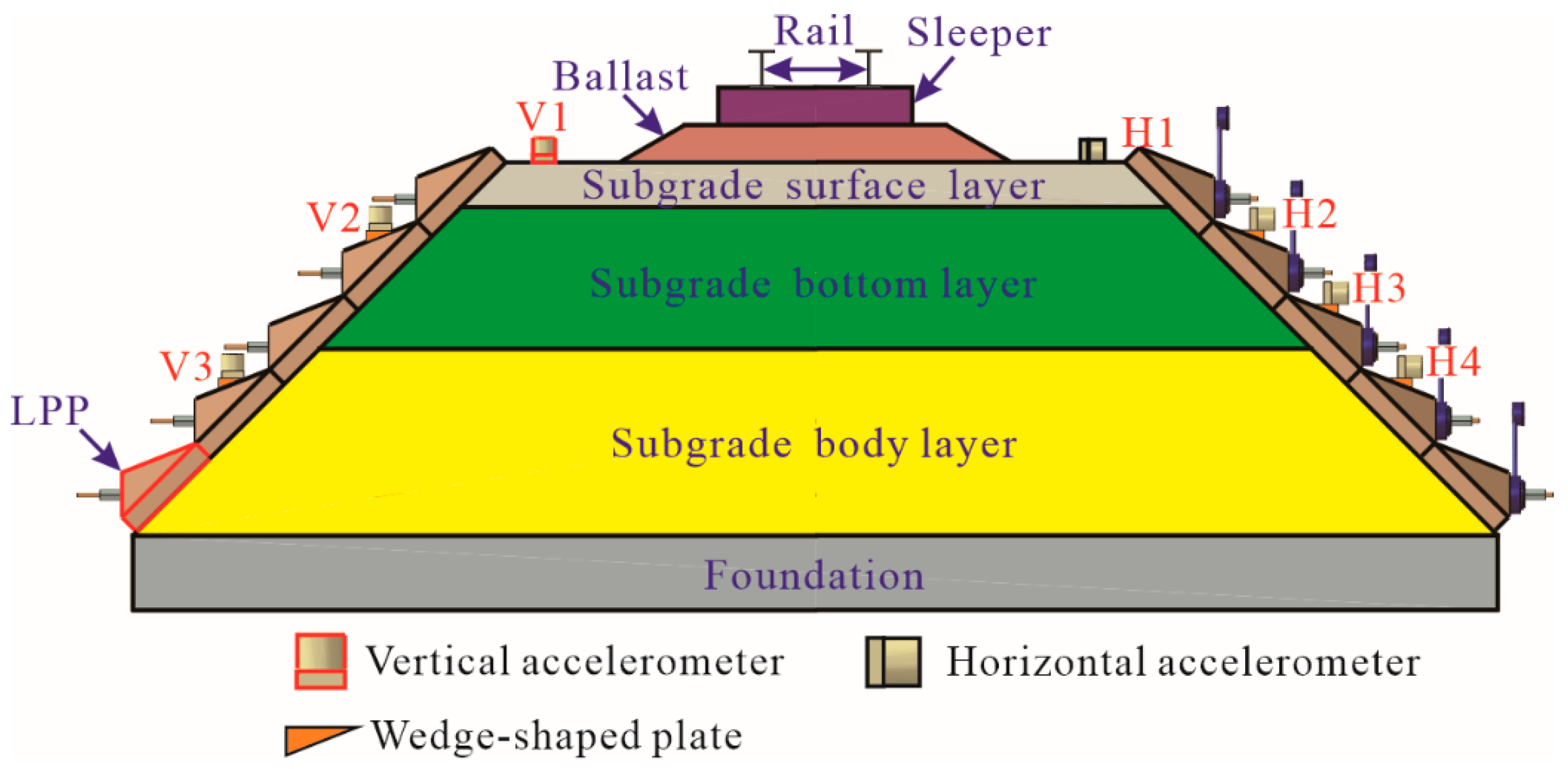
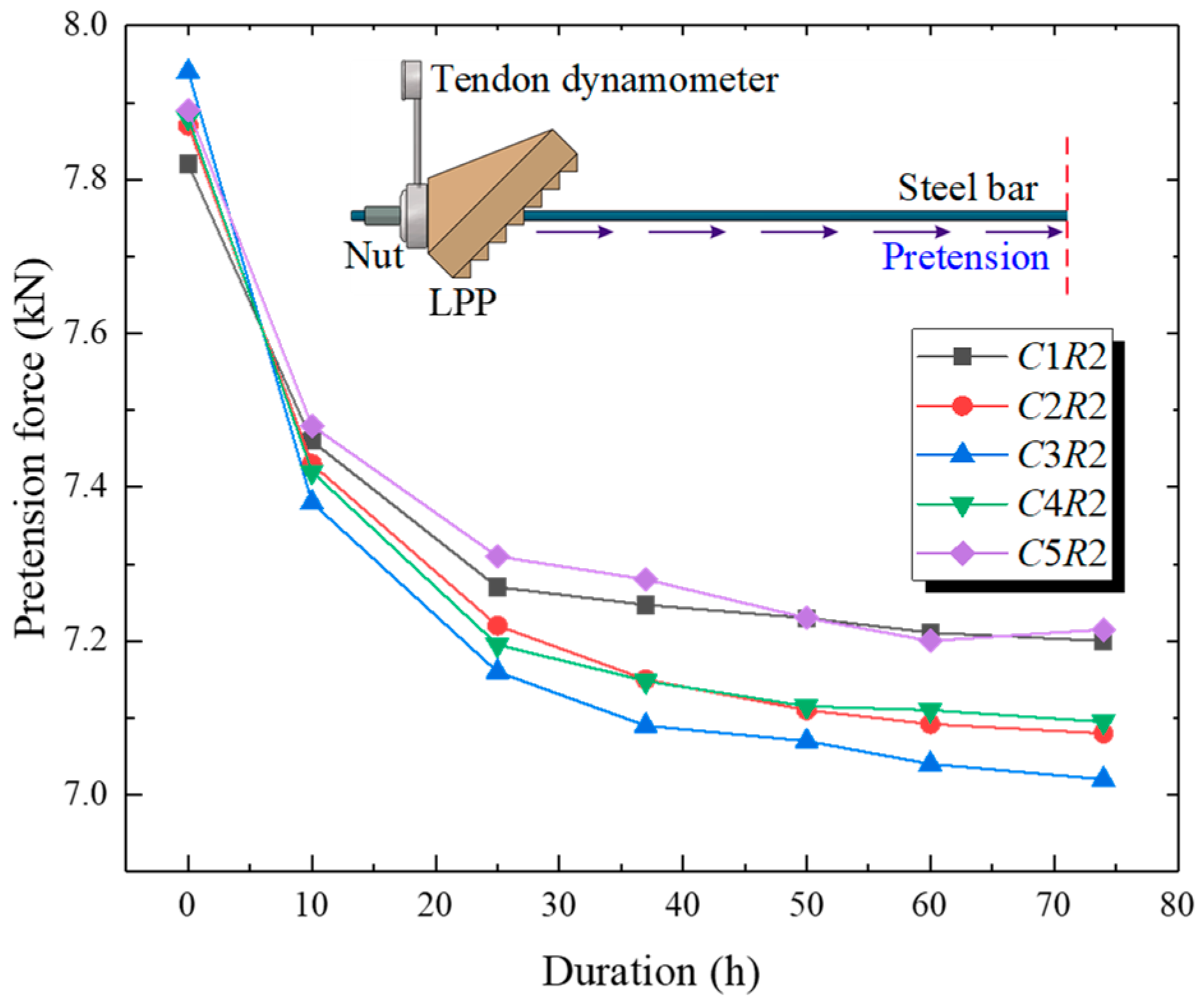



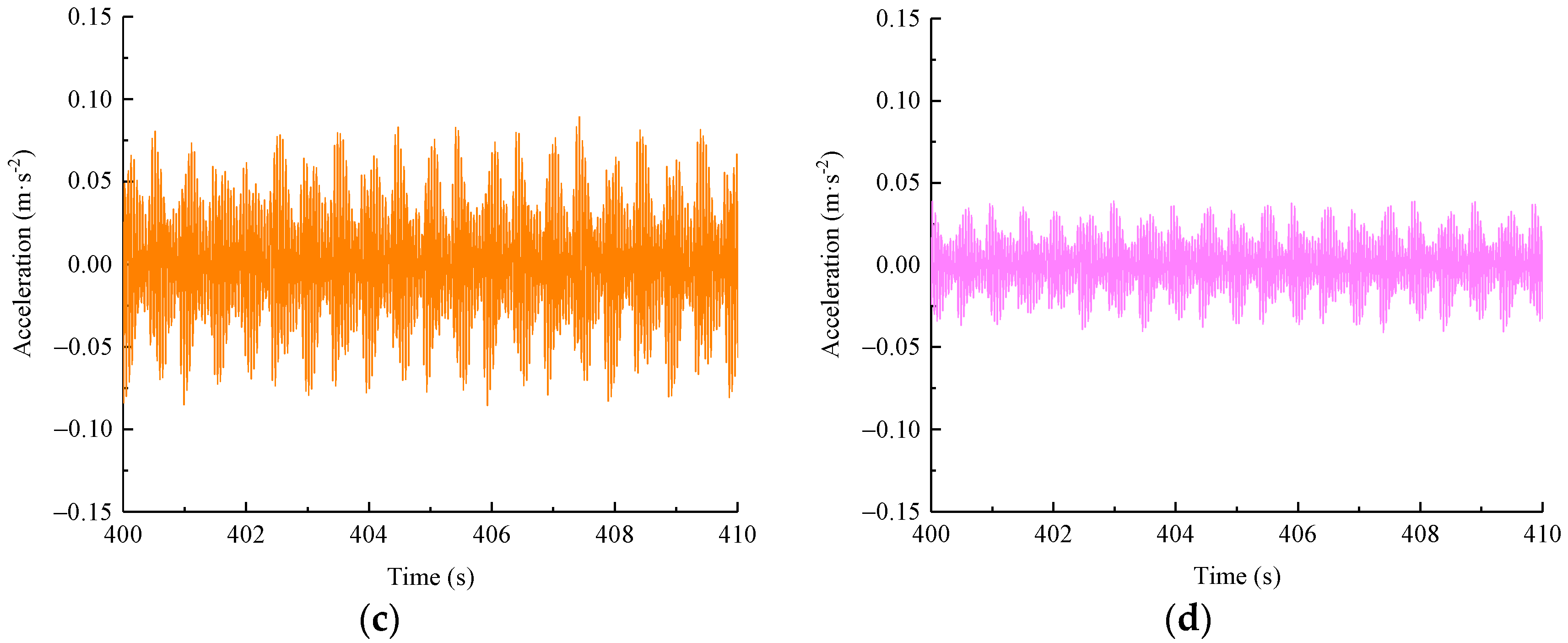



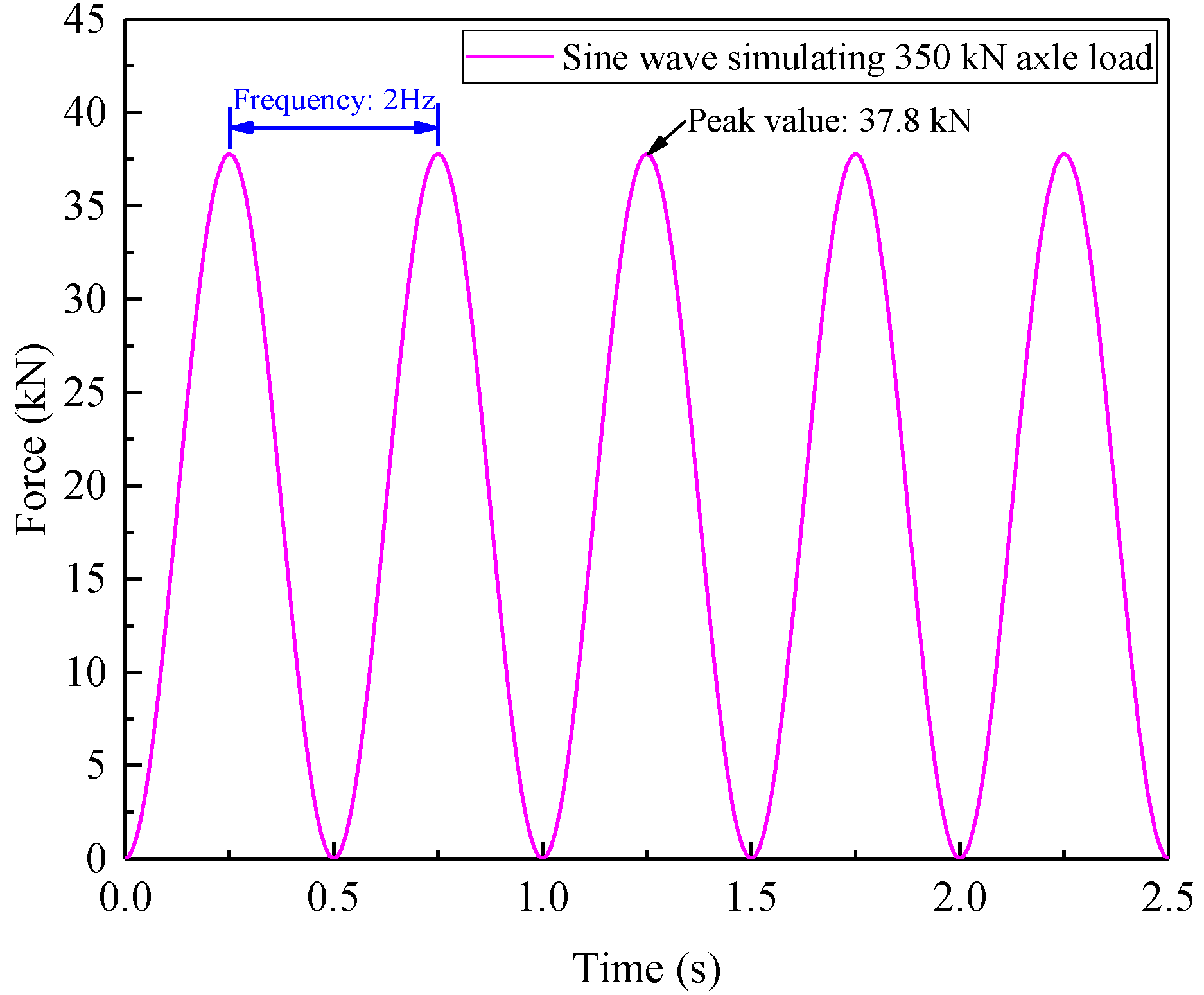
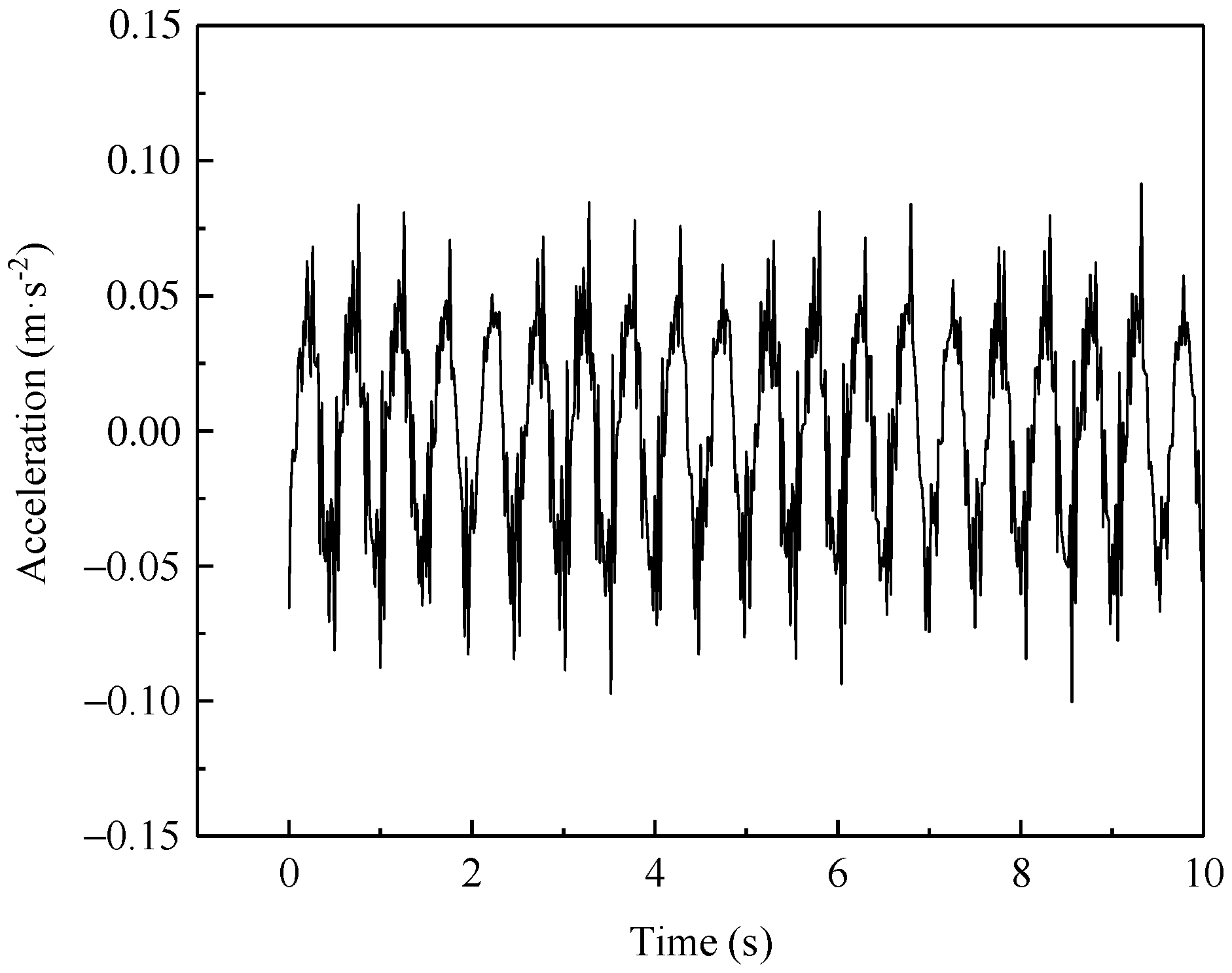
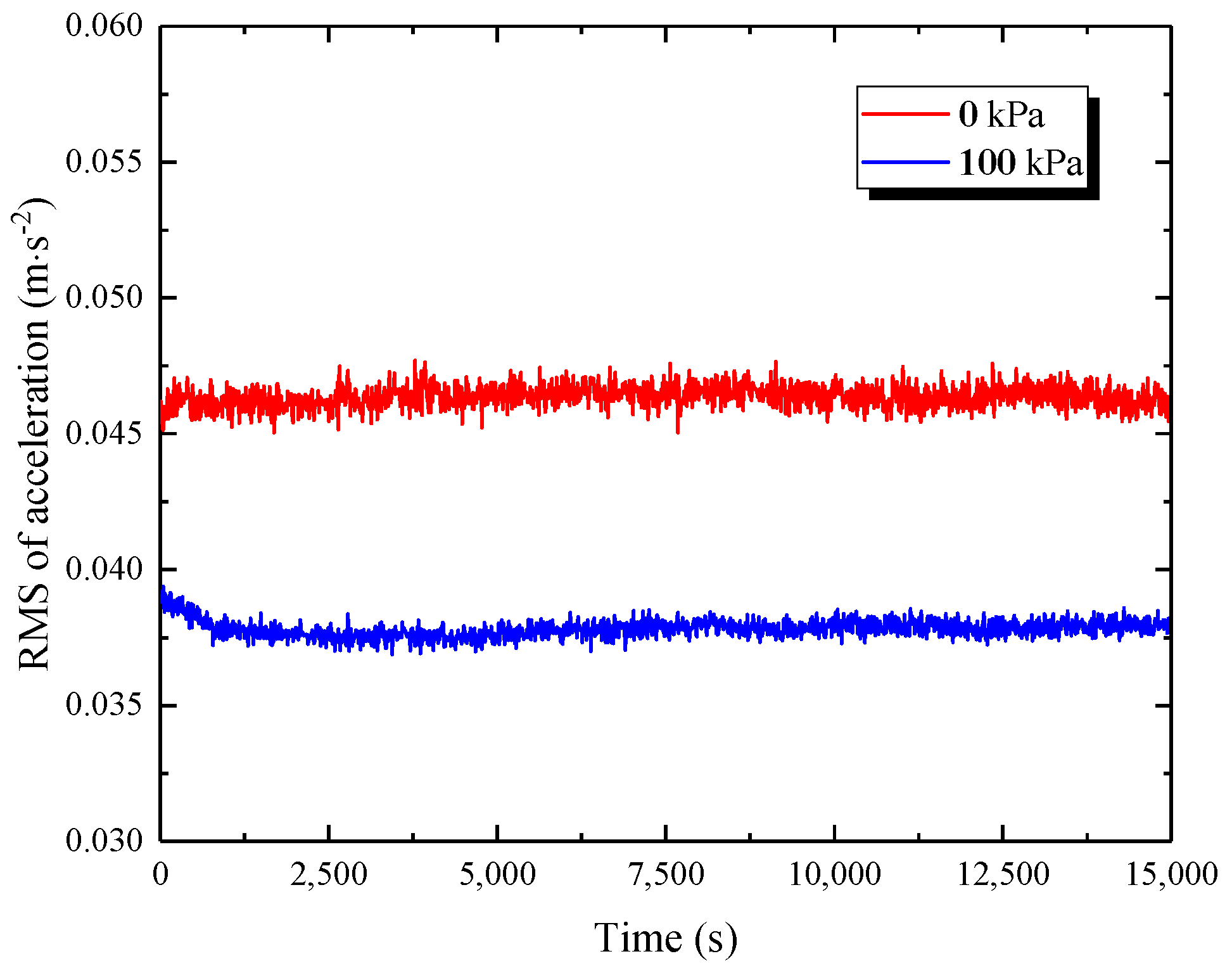
| No. | Variable | Symbol | Dimensions | Deduction | Similarity Ratio (Model/Prototype) |
|---|---|---|---|---|---|
| 1 | Geometric size | L | L | CL = CL | 1/5 |
| 2 | Elastic modulus | E | ML−1T−2 | CE = CE | 1 |
| 3 | Density | ρ | ML−3 | Cρ = Cρ | 1 |
| 4 | Stress | σ | ML−1T−2 | Cσ = CE | 1 |
| 5 | Time | t | T | Ct = (CL) (Cρ)1/2 (CE)−1/2 | 1/5 |
| 6 | Mass | m | M | Cm = (CL)3 (Cρ) | 1/125 |
| 7 | Force | P | MLT−2 | CP = (CL)2 Cρ | 1/25 |
| 8 | Displacement | s | L | Cs = CL | 1/5 |
| 9 | Acceleration | a | LT−2 | Ca = (CL)−1 (Cρ)−1 CE | 5/1 |
| 10 | Frequency | f | T−1 | Cf = (CL)−1 (Cρ)−1/2 (CE)1/2 | 5/1 |
| 11 | Frictional angle | φ | — | Cφ = 1 | 1 |
| 12 | Poisson’s ratio | μ | — | Cμ = 1 | 1 |
| 13 | Cohesion | c | ML−1T−2 | Cc = CE | 1 |
| Layer | Maximum Dry Density ρdmax (kg/m3) | Optimum Moisture Content ωopt (%) | Uniformity Coefficient (Cu) | Coefficient of Gradation (Cc) | Fillers Group |
|---|---|---|---|---|---|
| Subgrade bed | 2192 | 6.80 | 45.59 | 1.19 | A2 |
| Subgrade body | 2187 | 6.41 | 89.51 | 2.26 | B3 |
| Foundation | 2173 | 7.17 | 83.02 | 1.08 | B3 |
| No. | Test Series | Reinforcement Pressure (kPa) | Loading Cycles | Axle Load (kN) | Loading Wave |
|---|---|---|---|---|---|
| 1 | Short-term | 0 | 2000 | 230 | M-shaped wave |
| 2 | 25 | 250 | |||
| 3 | 50 | 270 | |||
| 4 | 75 | 300 | |||
| 5 | 100 | 350 | |||
| 6 | Long-term | 0 | 30,000 | 350 | sine wave |
| 7 | 100 |
| Axle Load (kN) | Reinforcement Pressure (kPa) | Peak Accelerations at All Measurement Points (m/s2) | ||||||
|---|---|---|---|---|---|---|---|---|
| V1 | V2 | V3 | H1 | H2 | H3 | H4 | ||
| 230 | 0 | 0.1137 | 0.1108 | 0.1050 | 0.0909 | 0.0890 | 0.0788 | 0.0364 |
| 25 | 0.1107 | 0.1069 | 0.1005 | 0.0908 | 0.0882 | 0.0788 | 0.0364 | |
| 50 | 0.1080 | 0.1040 | 0.0969 | 0.0888 | 0.0872 | 0.0773 | 0.0363 | |
| 75 | 0.1062 | 0.1018 | 0.0944 | 0.0884 | 0.0852 | 0.0758 | 0.0361 | |
| 100 | 0.1000 | 0.0967 | 0.0927 | 0.0876 | 0.0847 | 0.0761 | 0.0356 | |
| 250 | 0 | 0.1284 | 0.1218 | 0.1165 | 0.0984 | 0.0962 | 0.0861 | 0.0395 |
| 25 | 0.1238 | 0.1203 | 0.1134 | 0.0977 | 0.0954 | 0.0851 | 0.0395 | |
| 50 | 0.1234 | 0.1206 | 0.1123 | 0.0943 | 0.0928 | 0.0820 | 0.0383 | |
| 75 | 0.1212 | 0.1186 | 0.1065 | 0.0932 | 0.0915 | 0.0814 | 0.0392 | |
| 100 | 0.1144 | 0.1100 | 0.0994 | 0.0930 | 0.0905 | 0.0803 | 0.0387 | |
| 270 | 0 | 0.1445 | 0.1355 | 0.1304 | 0.1045 | 0.1030 | 0.0913 | 0.0424 |
| 25 | 0.1411 | 0.1318 | 0.1278 | 0.1035 | 0.1022 | 0.0907 | 0.0422 | |
| 50 | 0.1353 | 0.1284 | 0.1220 | 0.1013 | 0.0995 | 0.0893 | 0.0412 | |
| 75 | 0.1327 | 0.1269 | 0.1213 | 0.0995 | 0.0973 | 0.0857 | 0.0408 | |
| 100 | 0.1288 | 0.1237 | 0.1168 | 0.0968 | 0.0944 | 0.0864 | 0.0407 | |
| 300 | 0 | 0.1622 | 0.1491 | 0.1425 | 0.1118 | 0.1098 | 0.0979 | 0.0460 |
| 25 | 0.1615 | 0.1510 | 0.1441 | 0.1107 | 0.1084 | 0.0971 | 0.0454 | |
| 50 | 0.1574 | 0.1449 | 0.1400 | 0.1097 | 0.1071 | 0.0949 | 0.0441 | |
| 75 | 0.1478 | 0.1417 | 0.1337 | 0.1059 | 0.1035 | 0.0926 | 0.0429 | |
| 100 | 0.1468 | 0.1417 | 0.1352 | 0.1025 | 0.1001 | 0.0913 | 0.0439 | |
| 350 | 0 | 0.1903 | 0.1776 | 0.1729 | 0.1213 | 0.1182 | 0.1038 | 0.0488 |
| 25 | 0.1874 | 0.1746 | 0.1691 | 0.1204 | 0.1175 | 0.1046 | 0.0492 | |
| 50 | 0.1798 | 0.1677 | 0.1625 | 0.1198 | 0.1165 | 0.1031 | 0.0484 | |
| 75 | 0.1782 | 0.1643 | 0.1588 | 0.1177 | 0.1143 | 0.1015 | 0.0478 | |
| 100 | 0.1744 | 0.1638 | 0.1578 | 0.1106 | 0.1073 | 0.0976 | 0.0469 | |
Publisher’s Note: MDPI stays neutral with regard to jurisdictional claims in published maps and institutional affiliations. |
© 2022 by the authors. Licensee MDPI, Basel, Switzerland. This article is an open access article distributed under the terms and conditions of the Creative Commons Attribution (CC BY) license (https://creativecommons.org/licenses/by/4.0/).
Share and Cite
Zhang, Q.; Leng, W.; Dong, J.; Xu, F. Dynamic Response Characteristics of Railway Subgrade Using a Newly-Developed Prestressed Reinforcement Structure: Case Study of a Model Test. Materials 2022, 15, 6651. https://doi.org/10.3390/ma15196651
Zhang Q, Leng W, Dong J, Xu F. Dynamic Response Characteristics of Railway Subgrade Using a Newly-Developed Prestressed Reinforcement Structure: Case Study of a Model Test. Materials. 2022; 15(19):6651. https://doi.org/10.3390/ma15196651
Chicago/Turabian StyleZhang, Qishu, Wuming Leng, Junli Dong, and Fang Xu. 2022. "Dynamic Response Characteristics of Railway Subgrade Using a Newly-Developed Prestressed Reinforcement Structure: Case Study of a Model Test" Materials 15, no. 19: 6651. https://doi.org/10.3390/ma15196651




